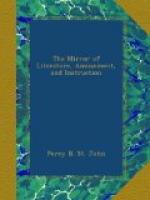The origin of prairies has occasioned much theory; it is to our mind very simple: they are caused by the Indian custom of annually burning the leaves and grass in autumn, which prevents the growth of any young trees. Time thus will form prairies; for, some of the old trees annually perishing, and there being no undergrowth to supply their place, they become thinner every year; and, as they diminish, they shade the grass less, which therefore grows more luxuriantly; and, where a strong wind carries a fire through dried grass and leaves, which cover the earth with combustible matter several feet deep, the volume of flame destroys all before it; the very animals cannot escape. We have seen it enwrap the forest upon which it was precipitated, and destroy whole acres of trees. After beginning;, the circle widens every year, until the prairies expand boundless as the ocean. Young growth follows the American settlement, since the settler keeps off those annual burnings.
American Quarterly Review.
* * * * *
SUTTON WASH EMBANKMENT.
This is said to be one of the grandest public works ever achieved in England. It is an elevated mound of earth, with a road over, carried across an estuary of the sea situated between Lynn and Boston, and shortening the distance between the two towns more than fifteen miles. This bank has to resist, for four hours in every twelve, the weight and action of the German Ocean, preventing it from flowing over 15,000 acres of mud, which will very soon become land of the greatest fertility. In the centre the tide flows up a river, which is destined to serve as a drain to the embanked lands, and has a bridge over it of oak, with a movable centre of cast iron, for the purpose of admitting ships.
* * * * *
BRITISH IRON TRADE.
The following view of the progressive and wonderful increase of the iron-trade is extracted from the Companion to the Almanac for 1829:—
Iron made in Number Great Britain. of Tons. Furnaces. In 1740 17,000 59 1788 68,000 85 1796 125,000 121 1806 250,000 1820 400,000 1827 690,000 284
The difference iron districts in which it is made are as under, in 1827:
Tons. Furnaces. South Wales, 272,000 90 Staffordshire, 216,000 95 Shropshire, 78,000 31 Yorkshire, 43,000 24 Scotland, 36,500 18 North Wales, 24,000 12 Derbyshire, 20,500 14
“About 3/10ths of this quantity is of a quality suitable for the foundry, which is all used in Great Britain and Ireland, with the exception of a small quantity exported to France and America. The other




